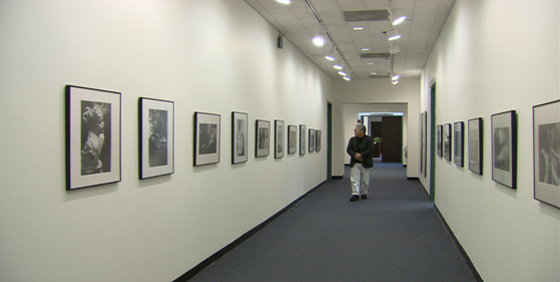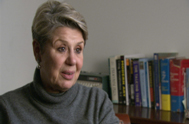|
|
|
■Introduction to the exhibition ORANGE
|

|
|
Dead trees, Boun Me Tout, 1981
|

|
Abandoned Amerasian Girl (Saigon,1982)
|

|
Veterans Exposed to Agent Orange Protesting (Washington D.C., Vietnam Veteran’s Day, 1982)
|

|
(left): Jeniffer,Agent Orange Child (1982),(Her father Daniel J. Roney was a Vietnam veteran, Philadelphia, 1982)
(right): Jenny with Daniel (Daniel killed himself in 2002, Philadelphia, 1994)
|

|
Buu Thi Lam with Hien, Blind Daughter (Hanoi, 1981, Lam’s Husband was sprayed with Agent Orange.)
|

|
A Young Woman and Soldier Dancing (The photograph was found in the U.S. Embassy in Saigon after the evacuation, 1975)
|

|
Christmas Eve on the Banks of the Saigon River (1981)
|

|
A Lush Forest Once Upon a Time (Ca Mau, 1976)
|

|
A Girl with Developmental Disorder (She was born in a community awash in pollution from former U.S. base in Bien Hoa, 2006)
|

|
Vietnam Veterans and “The statue of soldiers” (Washington D.C., 1982)
|

|
Le Thi Thay and Ten Month Old Ha (Loc Hung, Tay Ninh Province, 1981)
|

|
Desolate Landscape (Vinh Linh District, DMG, 1974)
|
DURING THE RENAISSANCE, both scientists, scholars and artists pursued empirical goals.
Scientists attempted to understand the physical world more precisely than previous generations had,
artists tried create works of art that reflected ever more accurately representations of observed reality.
John Jay College of Criminal Justice is proud to present“Orange”...
an exhibit documenting the relationship between science and art and criminal justice.
The exhibit presents an international photojournalist, Goro Nakamura,
who has created a documentary on the affects of Agent Orange or Dioxin on Vietnam veterans and the local Vietnamese population.
Understanding how a scientific chemical was utilized to help in warfare the unanticipated damage on human
life addresses an issue close to the mission of the College. For after all,
a person's intent may not be criminal but the end result of behavior may became a case of
injustice or even criminal attribution.
An international leader in educating for justice,
John Jay offers rich liberal arts and professional studies curricula to a diverse student
body in a vibrant urban setting.
In teaching and research, the College defines justice both narrowly,
with eye to the needs of criminal and public service agencies, and broadly
and humanistically in terms of enduring questions about fairness, equality and the rule of law.
|
TOVA FRIEDLER
VICE PRESIDENT FOR INSTITUTINAL ADVANCEMENT
JOHN JAY COLLEGE OF CRIMINAL JUSTICE
|

GORO NAKAMURA: ORANGE
|
NAKAMURA is an award winning international photojournalist who has dedicated the better part of his life to photographing
the affects of Agent Orange or Dioxin on both its local victims and Vietnam veterans. Agent Orange (named after the orange
stripes on the canisters that contained one of the most toxic forms of dioxin) started being used in 1962 when President Kennedy
encouraged by President Diem, felt they needed radical means to deal with the Vietcong inhabiting the Vietnamese forests.
While hoping only to destroy the crops that fed them, and to deforest the hideouts of their enemy they initiated spraying
with Dioxin and by“1967.1.5 million acres were being doused annually, ravaging rubber and coconut plantations as half
the Mekong Delta's mangrove forest, and inadvertently hitting fruit orchards due to wind drift and vaporization.
In total, an estimated 20 million gallons of the defoliant were sprayed from planes, helicopters, or armored cars.”
According to Fodor's Exploring Vietnam (1998) 1969 laboratory studies proved a link between Agent Orange and many of birth defects,
cancers, and skin diseases.
In 1971, when as a result of this study it was realized the chemicals were harmful the spraying was halted but it
was already too late for the chemicals had permeated the ecosystem and already five million acres of mangroves had
been destroyed while tens of thousands of troops on both sides had been exposed to the chemical.
Through his sensitive photographs Nakamura transforms mere photojournalism into art with a powerful statement.
As evinced by the compositional design of Desolate Landscape: Vinb Linb, Near the DMZ, 1974, there is overall
evidence of balance at play both because of the craters on each side of the lone woman but also because of the hanging
baskets from the pole on her shoulders. Because of its overarching balance, the image initially conveys order preventing
us from immediately comprehending the work's deeper significance However, once we see that looming clouds above the subject,
both in their asymmetrical weight and in their threatening character result in fragile tension, we try to make sense of its origin.
It is after this point that the viewer comprehends the devastation that the land has suffered from bombings and spraying with Dioxin.
Nakamura's poignant images of Dioxin victims don't merely record the devastation resulting from these chemicals but are also
bittersweet essays into the human psyche that despite much suffering manages to find some positive aspect in life as seen in Jennifer,
Philadelphia, 1982.
this photograph depicts the beautiful curly-haired blonde two year old Jennifer with a congenital malformation in her right arm caused
by the Dioxin spraying that took place while her father was in Vietnam serving in the US military.
Years later, Nakamura documented her development by photographing Jennifer again as seen in Jennifer with Daniel, 1994.
Father and daughter look happy next to each other Jennifer sits on a bicycle whose left handle Daniel appears to steer.
He is proud of his daughter and his gaze is fixed as if to the future while Jennifer seems to be coping well with her challenge.
But, despite this somewhat optimistic façade, in 2003, as a result of Post Traumatic Service Disorder from the Vietnam conflict
Daniel committed suicide.
Although the protagonists' ethnicity or skin color may differ, this scenario is typical of the tragedy of war.
Nakamura's black and white glossies depict American Vietnam veterans with their disabled children who still manage to smile for the camera.
Or, he portrays Vietnamese children playing in rice fields while hobbling around on crutches.
Nakamura's viewpoint of such horror although heart-wrenching, is nevertheless Life-affirming.
By depicting the horrors of war in all their graphic realism, he hopes to exorcize them from our future.
In one of his interviews for a local television program Nakamura was asked the reason for dedicating life
to documenting the effects of Agent Orange to which he responded that he was interested in documenting similar tragedies from
all over theworld including Hiroshima and Nagasaki.
He explained that his interest began when in 1976 he visited South and North Vietnam to cover the postwar developments.
He found the mangrove forests totally devastated resulting in palpable silence without birds chirping or leaves falling.
A midwife Nakamura met in Ca Mau told him that there were large numbers of babies born with deformities and almost all
of the pregnant women experienced miscarriage or had stillborns.
Although Nakamura already had an interest in this type of documentary, this was definitive moment for his decision to devote
his life to helping victims of war.
Compiling clinical data proved very difficult because of its scarcity, thus if fell on Nakamura to establish the bona
fide cases by gathering facts while photographing the victims. One of the most tragic cases is reflected in Nakamur's
Buu tbi Lam with Hien,1981 a black and white photograph of a mother named Buu Thi Lam, 43 years old with her
blind 8 year old daughter Hien sitting on her lap. This woman living in Hanoi was married to a GI who was exposed to
Dioxin and who passed on his mutant genes to two congenitally blind daughters. Though the sweet child on the woman's
lap with head slightly inclined portrays resignation her mother’s pained expression like the Virgin Mary's in Masaccio's
Holy Trinity seems to be relating with the viewer as if beseeching while also accusing him for what’s happened to her innocent child.
Although Nakamura has taught photography and journalism at other schools including Yamanashi University, and the
Institute of Modern photography, he is Professor Emeritus from Gifu University where he taught photojournalism for many
years until his retirement.
He has been working in the field as correspondent and photojournalist for Asian News Service since 1961 and for the Japan press since 1967.
Nakamura has been recording the effects of Agent Orange on victims for the past thirty years during which time he's come into contact
with plethora of victims not only in Vietnam but also the United States and Korea.
In the late 90's Nakamura produced a successful TV documentary on Agent Orange, or Dioxin commonly used to burn wastes by many
industrialized countries.
Since 1974 Nakamura has written four books on the topic that have each sold anywhere from 7,000 to 270,000 copies.
Nakamura was nominated for the Eugene Smith award of 1983, and received the 8yh Ina Nobuo Prize,
in 1983 from Nikon for best photographer of the year, as well as a special prize from the 1995 Congress of Journalists.
Last year Nikon hosted his exhibition “30 Years Tracing of Agent Orange”held at their gallery in Ginza,
Tokyo and traveling to Osaka Nikon.
|

DR. THALIA VRACHOPOULOS, PH.D,
Jhon Jay Collage of Criminal Justice
|
|
|
|

